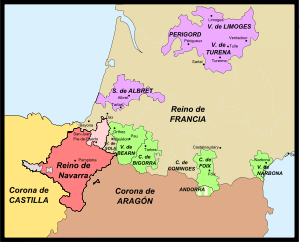
Back الغزو الإسباني لنبرة الإيبيرية Arabic Conquesta de Navarra Catalan Goresgyniad Teyrnas Navarra gan y Sbaenwyr Welsh Conquista de Navarra Spanish Nafarroako konkista Basque فتح ناوارای ایبری توسط اسپانیا Persian Conquête espagnole de la Navarre French Conquista de Navarra Galician Španjolsko osvajanje iberske Navare Croatian Իսպանացիների կողմից Նավառայի նվաճումը Armenian
| Conquest of Navarre | |||||||||
|---|---|---|---|---|---|---|---|---|---|
| Part of the War of the Holy League | |||||||||
 In red, the lands of Navarre occupied by Ferdinand. In pink, the remaining Kingdom of Navarre which survived until Louis XIII of France, II of Navarre. | |||||||||
| |||||||||
| Belligerents | |||||||||
|
|
| ||||||||
| Commanders and leaders | |||||||||
|
King Ferdinand II Duke of Alba Charles V, Holy Roman Emperor Duke of Nájera |
King John III Henry II of Navarre Pedro, Marshal of Navarre André de Foix Cesare Borgia | ||||||||
The Spanish conquest of the Iberian part of Navarre was initiated by Ferdinand II of Aragon and completed by his grandson and successor Charles V in a series of military campaigns lasting from 1512 to 1524. Ferdinand was both the king of Aragon and regent of Castile in 1512. When Pope Julius II declared a Holy League against France in late 1511, Navarre attempted to remain neutral. Ferdinand used this as an excuse to attack Navarre, conquering it while its potential protector, France, was beset by England, Venice, and Ferdinand's own Italian armies.
Several attempts were made to reconquer Iberian Navarre immediately following the Castilian invasion. There was a half-hearted attempt in 1516 and a full-fledged Franco-Navarrese campaign in 1521. All attempts were defeated by the Spanish and clashes came to a halt in 1528, when Spanish troops withdrew from Lower Navarre north of the Pyrenees. The Treaty of Cambrai between Spain and France in 1529 sealed the division of Navarre along the Pyrenees.
The portion annexed by Castile also came to be known as Upper Navarre, while the portion north of the Pyrenees, also called Lower Navarre, remained an independent kingdom, ruled by the House of Albret, and maintained close links with France. The kingdom was in personal union with France after 1589 and absorbed into France in 1620. It ceased to exist as an administrative division in 1790. Upper Navarre lost its status as a kingdom at the end of the First Carlist War.[1]
- ^ Orella Unzué, Jose Luis (2015-11-02). "Convenio navarro o Ley Paccionada de 1841". Naiz. Naiz. Retrieved 2015-11-27